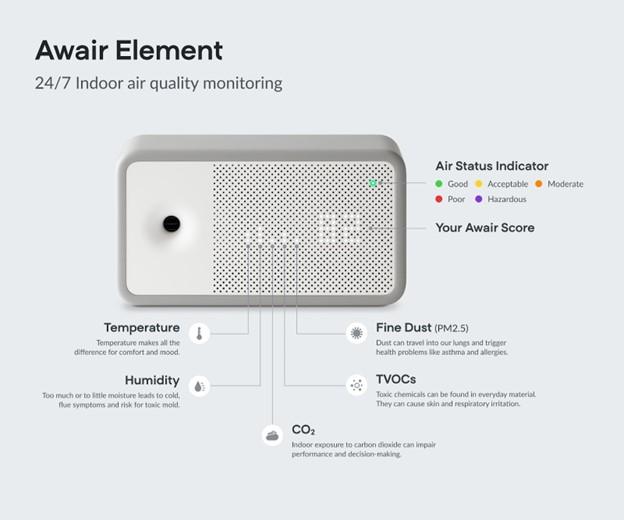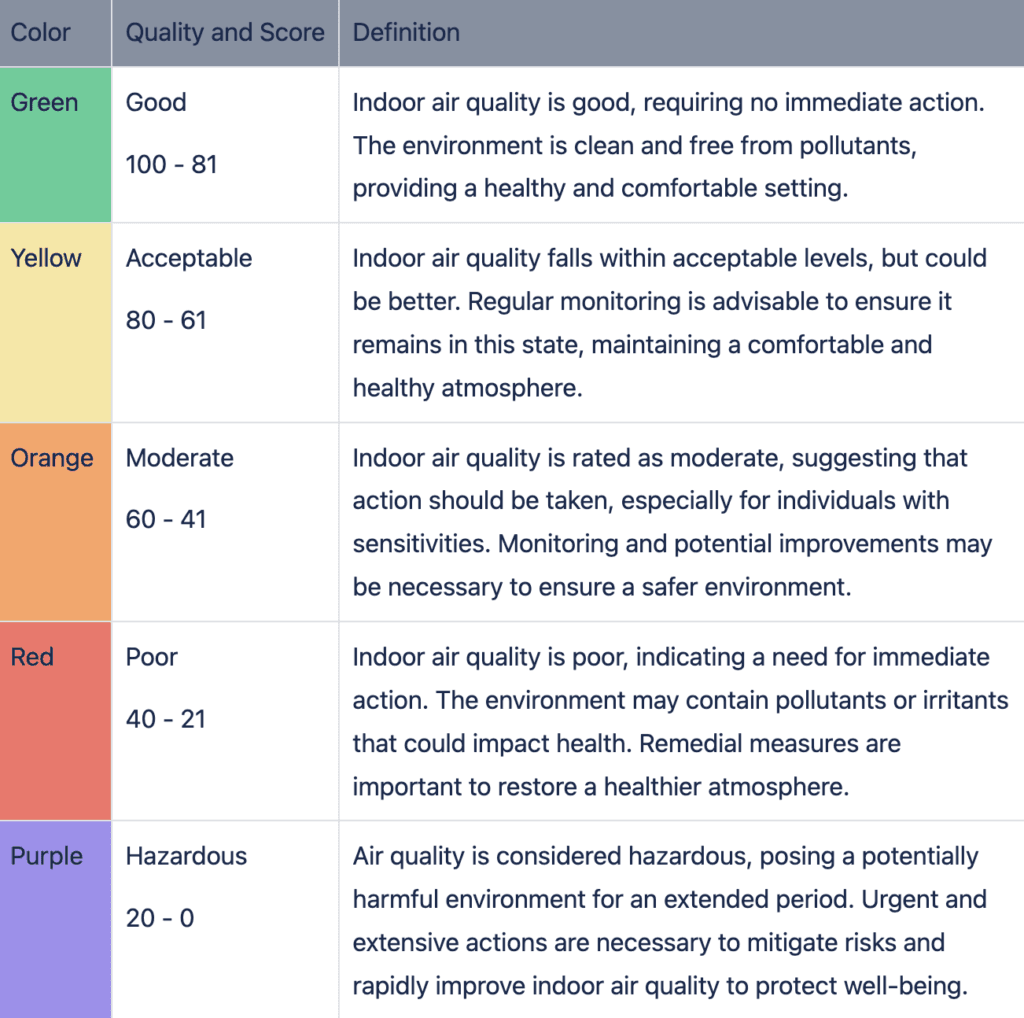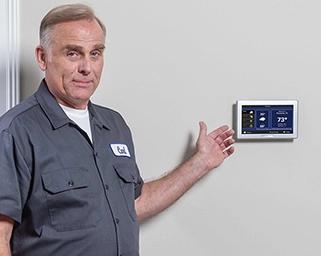The Awair Element Air Quality Monitor: A Smart Solution
Learn how an air quality monitor can help you protect your family’s health and increase your home comfort.

By Anne Fonda
Home comfort isn’t just about how warm or cool it is. Your indoor air quality can positively or negatively affect your comfort and even your health. We’ve found a solution to help you breathe easier.
Your American Standard HVAC system works even smarter with the Awair Element, an indoor air quality monitoring device. It integrates seamlessly with the Home App and American Standard Diagnostics. American Standard has partnered with Awair to help you improve your indoor air quality, enhance comfort, and get peace of mind with accurate indoor air quality monitoring.
How do I know if I have poor indoor air quality at home?
Indoor air pollution may be odorless and invisible to the naked eye. But some people are more sensitive to indoor air pollutants than others and may exhibit health symptoms. Some key indicators of poor IAQ in your home include:
- Stubborn odors such as pet smells or cooking odors
- Musty smell
- Increased dust
- High humidity or low humidity
- Mold growth
- Headache only at home
- Respiratory issues only at home
If you or a family member suffers from headaches or respiratory symptoms at home but not when you’re at work or school, it’s time to find out why. An air quality monitor may help you solve the mystery.
What is air quality monitoring?
Air quality monitoring involves installing an IAQ monitor in your home to detect specific factors that affect the quality of indoor air. Air quality monitors can help identify pollutant levels, as well as less-than-optimal humidity levels and problematic temperatures.
How does the Awair air quality monitor work?
This smart indoor air monitor helps you maintain a healthy home, using advanced technology. Tested and modified since 2013, the signature design using a fan and laser sensor has made Awair a leader in air quality monitoring.

Source: Awair
The Awair smart home air quality monitor tracks 5 key environmental factors that can affect your health. As shown in the graphic above, it displays air status indicators with colored lights representing levels from Good to Hazardous and displays an Awair Score from 0 to 100. The higher the score, the better your indoor air quality. Since it can be integrated with the Home App, you can see all of these indicators on your smartphone as well
Let’s examine what the Awair Element monitors and how your smart HVAC system responds to levels less than Good.
Temperature
The device monitors your home’s air temperature and gives a score for each range. For example, Good = 68-77°F. This is the indoor temperature range that is best for your home comfort and health. The Acceptable, Moderate, Poor, and Hazardous temperature ranges will vary based on whether you are heating or cooling.
When the Awair Element is linked to your smart HVAC system, temperatures outside the Good range can signal the heat or air conditioning to come on.
Humidity
The Awair Element also measures humidity levels. Maintaining the recommended indoor humidity level is essential to your comfort, health, and the protection of your home. For humidity, Good = 40-50%.
Low humidity is most common in the winter and arid climates. It can cause static electricity, dry skin, chapped lips, nosebleeds, respiratory symptoms, and drying and cracking of wood. High humidity can produce an environment that’s perfect for mildew and mold growth, causing a musty smell, respiratory issues, and more.
When the Awair device is linked to your HVAC system, humidity levels above or below the Good range can trigger the heat or air conditioning, whole-house humidifier, or whole-house dehumidifier to come on.
Carbon Dioxide (CO2) in ppm
The unit monitors CO2 levels as well. Outdoor levels of carbon dioxide hover around 400 ppm (parts per million). So Good = <500-600 ppm. When levels of CO2 rise, it can trigger your whole-house ventilator to increase the air exchange.
Volatile Organic Compounds (VOCs)
Volatile organic compounds (VOCs) are chemicals found in the air. They commonly originate from things like cleaning products, paints, sealants, new carpeting, sealed wood, and more. Moderate to high levels of VOCs can cause headaches, cough, allergic reactions, nausea, dizziness, and other symptoms.
The Awair Element measures total VOCs, or TVOCs. Good = 0-300. When VOC levels rise, it can trigger your whole-house ventilation system to increase the air exchange rate. It can also cause your whole-house air purification system to enter Quick Clean or Allergy mode to operate the air cleaner and fan at full speed even if the HVAC system isn’t running.
PM2.5
PM2.5 represents fine particulate matter (PM). You can inhale these tiny particles, which, according to the Environmental Protection Agency (EPA) and multiple scientific studies, can lead to irritation and even severe respiratory conditions like chronic obstructive pulmonary disease (COPD) and lung cancer. For PM2.5, Good = 0-12 micrograms per cubic meter (µg/m³). Higher levels of particulate matter can trigger your air purification system or ventilation system to help clear the air.
Your Awair Score at a glance

Source: Awair
For your convenience, you can also see all of this on your smartphone through the Trane Home App once you have integrated the Awair Element with your system. This allows you to monitor your air quality from anywhere.
Read this article on Understanding Your Awair Score for more detailed information.
"Indoor air quality plays a critical role in your family’s health and comfort—yet it’s often overlooked. By pairing the Awair Element with an American Standard HVAC system and smart thermostat, homeowners gain real-time visibility into key air quality metrics like temperature, humidity, and pollutants. With smart monitoring and control, customers can breathe easier knowing their air is working as hard as their HVAC system."
-David Lothe, Communications and Accessories Product Manager

How can I improve my indoor air quality?
If the Awair Element indicates problems with your indoor air quality, you can take steps to improve it. Your American Standard dealer can help you with many of these IAQ issues.
Possible solutions include:
- Installing a whole-house ventilator for stale or VOC-polluted air
- Installing a whole-house air purification system to filter out tiny particles
- Installing a whole-house humidifier for low humidity
- Installing a whole-house dehumidifier for high humidity
- Upgrading your existing HVAC system
- Practicing good HVAC maintenance
- Reducing VOCs by making wise purchases
- Banning smoking or vaping indoors
- Embracing houseplants
Is an air quality monitor worth the cost?
At a one-time cost of +/- $200 before discounts, an air quality monitor like the Awair Element can be worth every penny, especially if anyone in your family has respiratory issues or you live in an area with known air quality issues.
By detecting pollutants like PM2.5 and VOCs and triggering an HVAC system response to activate the fan or blower to circulate and clean the air, detecting high or low humidity, and starting up humidity control equipment, the Awair Element partners with your HVAC system to provide cleaner, healthier living.
Backed by American Standard’s dealer network, you gain peace of mind knowing your home’s air quality is monitored, managed, and optimized 24/7.
Work with the home comfort experts
From energy-efficient residential heating and cooling solutions to improving your indoor air quality, your local American Standard dealer can help you optimize your home comfort. Reach out today to find smart solutions for your home.
Content Writer, Trane Technologies
A Content Writer with Trane Technologies, Anne Fonda researches topics and writes for Trane® and associated residential HVAC brands. She works in collaboration with Trane Technologies subject matter experts, offering easy-to-understand, informative content on complex topics. Her goal is to help consumers make informed decisions on the products and services they need.
She has written for HVAC and other service provider websites for over 16 years. Before transitioning to web content writing, Anne had a 14-year stint as an award-winning journalist. She graduated cum laude from the University of Missouri-Columbia School of Journalism.
When she’s not working, Anne enjoys playing word games, reading, gardening, spending time with family, and visiting gardens and museums.
Expert review by Lori Alexander, Digital Solutions Marketing Manager
Related articles



